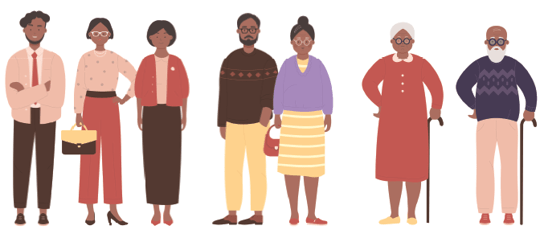Love your bones, and they’ll take good care of you throughout your life.


Peak bone growth occurs during childhood, but bones continue to grow throughout life. “Bone is a pretty amazing thing,” says Richard Yoon, MD, Director of Orthopedic Research at Jersey City Medical Center and a member of RWJBarnabas Health Medical Group. “Bone is always in turnover, constantly being broken down and built back up at every age.”
The process of building up new bone becomes less efficient as we get older, which can lead to osteopenia and osteoporosis, conditions in which bones become more brittle and prone to fracture. Fortunately, adults can take diet and lifestyle steps at every age to keep their bones as strong as possible.
Ages 20 to 39
Age-Related Concerns
“The most important thing is to develop and maintain good eating and exercise habits,” says Dr. Yoon. “If you do that now, you’re setting yourself up for lifelong good bone health as well as cardiovascular health and weight maintenance.”
What to Eat
The focus should be on an overall healthy and balanced diet. “People this age don’t necessarily have to focus on their levels of calcium and vitamin D [important bone nutrients] because a well-balanced diet will usually take care of these requirements, and the body at this age will use what it needs,” Dr. Yoon says. For strong bones, limit alcoholic drinks to no more than one a day for women and two a day for men, and avoid nicotine.
How to Exercise
As people enter their 30s, they are still strong enough to continue with their usual aerobic and weight-bearing activities, but should be increasingly careful because injury recovery takes longer. Over the course of a week, 150 minutes of exercise is recommended.
Ages 40 to 55
Age-Related Concerns
In peak career years, time is tight but exercise should not be neglected. For women, these are the perimenopausal years, in which bone loss increases due to dropping estrogen levels. Women should have a baseline bone density scan now.
Because men tend to have bigger and wider bones, they are less at risk for osteoporosis than women are. However, low testosterone levels can lead to loss of bone mass in men.
What to Eat
It’s especially important now to make sure your body is getting enough calcium and vitamin D. Minimize drinking (one alcoholic drink a day for women, two for men) and don’t use nicotine.
How to Exercise
Good exercises at this age include yoga and Pilates, which use bodyweight and are focused on general strengthening rather than building muscle. Get 30 minutes of exercise at least five days a week.
Ages 56 to 65
Age-Related Concerns
“Recognize that your reaction time is slower, and you might again need to change the type of exercise you do to avoid getting injured,” says Dr. Yoon. When women are postmenopausal, the loss of hormones means they should be especially attentive to bone health.
What to Eat
As at all ages, eat a well-balanced diet with lots of whole grains, fruits, and vegetables. “Postmenopausal women should probably take calcium and vitamin D supplements,” says Dr. Yoon. Underlying medical conditions that might affect bone health include diabetes, kidney issues, lactose intolerance, celiac disease, and Crohn’s disease.
How to Exercise
Instead of running, try walking or power walking. Consider cycling, stationary bicycling, spin classes, or any low-impact exercise that is great for the heart. “And recognize that if you’re having pain, then something isn’t right,” Dr. Yoon says. “Don’t push through it.”
Age 66 and up
Age-Related Concerns
Fractures start to become more common, often caused by daily activities, so slow down a bit, advises Dr. Yoon. “I can’t tell you how many times a patient around age 70 comes into the hospital with a hip fracture because they were cleaning their gutter,” he says. Older people are also more likely to have diabetes and other medical conditions that might make bones more brittle.
What to Eat
In addition to a healthy, well-balanced diet, vitamin and calcium supplements become even more important, because as people get older, malnutrition occurs at a higher rate. For stronger bones, limit or eliminate alcoholic drinks and don’t use nicotine.
How to Exercise
Workouts should include exercises that help improve balance. “Really focus on the core, the lower back, the hip girdle, the muscles around the waist,” says Dr. Yoon. “In addition to helping avoid falls, strong muscles fight chronic back, hip, and knee pain.”
Good overall exercises include walking, swimming, and seated exercises that can be done in a chair.
The good news is that there is no age limit for bone turnover.
“In older patients who are more active, the bone is stimulated to remodel when you are using it,” says Dr. Yoon. “The old saying ‘Use it or lose it’ is really true, and exercise is something that will help maintain your bone strength.”
Vitamin D and Calcium: Bone Health Superstars
Vitamin D
Recommended Daily Amount (RDA): For adults ages 19 to 70, 600 international units (IUs); for over age 70, 800 IUs.
Sources: Oily fish, such as salmon, trout, whitefish, and tuna; leafy greens; fortified foods, such as milk and cereal. Sunlight helps the body produce vitamin D. However, it can be difficult to eat enough vitamin D-rich foods and safely get enough sun for the recommended level, so supplements may be needed.
Calcium
Recommended Daily Amount (RDA): For adults ages 19 to 50, 1,000 mg, about the amount in two servings of calcium-rich food like dairy products. Increases to 1,200 mg a day for women after age 50 and for men after 70.
Sources: Dairy foods; broccoli and leafy greens; tofu; nuts; fortified orange juice. Keep a food diary for a week or two to see how much daily calcium you get on average.
To learn more about orthopedic services at Jersey City Medical Center, call 844.63.ORTHO (844-637-8460) or visit our Orthopedics page.